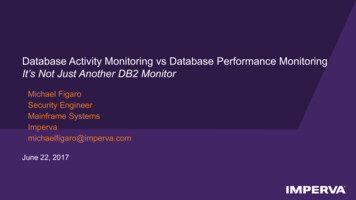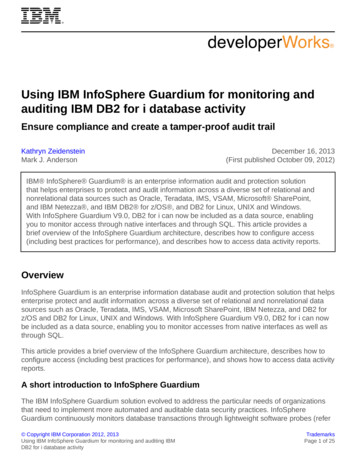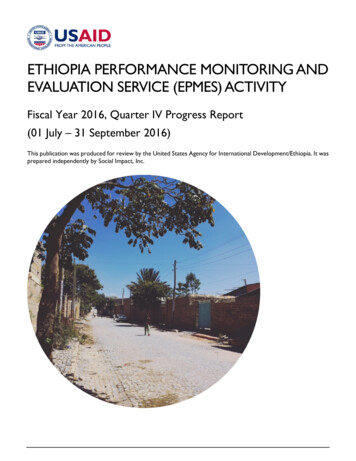
Transcription
Database Activity Monitoring vs Database Performance MonitoringIt’s Not Just Another DB2 MonitorMichael FigaroSecurity EngineerMainframe SystemsImpervamichaelfigaro@imperva.comJune 22, 2017 2016 Imperva, Inc. All rights reserved.
Agenda The Activity Monitor project The Real Goal– It’s probably DCAP The Differences Between DCAP and Performance MonitoringDCAP – The Core ElementsControlling MonitoringCommon Use CasesDCAP Reliability and PerformanceMake vs BuyAdditional Considerations 2016 Imperva, Inc. All rights reserved.
The Activity Monitor Project 2016 Imperva, Inc. All rights reserved.
It’s easy to go to the Sun, you just have to do it at 7763/ 2016 Imperva, Inc. All rights reserved.
Going to the Sun at night:”Database activity monitoring, it’s just another monitor, ealing-with-your-boss/Your boss walks up to your cube and says, “Hey, we’ve got this program the Security Team asked us toinstall. It has the ability log every activity that ever occurs on DB2. What do you think? You should beable to knock it out in a couple of days. It’s just another monitor, right?” 2016 Imperva, Inc. All rights reserved.
What are some questions that immediately come to your mind? What are they REALLY trying to do? What kind of stake should I want to have in this project?– Be educated about the subject. That is what we are doing right now. Do they really THINK they can monitor everything?Do they really NEED to monitor everything?What is this going to do to DB2 reliability?What is this going to do to resource consumption?Why don’t we make, instead of buy (using perf monitor asinput)? 2016 Imperva, Inc. All rights reserved.
more questions to consider. How much work is it going to be to install/maintain?What will my role be in the project? (identify sensitive data).Where is all this data going to go?What are some other desirable characteristics of DAM solutions? 2016 Imperva, Inc. All rights reserved.
The Real Goal 2016 Imperva, Inc. All rights reserved.
What are they really trying to do? Your manager and security team may not call it this, but “DCAP” is probablywhat they are trying to do? Who knows what DCAP stands for? 2016 Imperva, Inc. All rights reserved.
Big Picture KeyComponentsGartner MarketGuide for “DataCentric Audit andProtection”(DCAP)Source: Gartner, Market Guide for Data-Centric Audit and Protection, 22 November 201410 2016 Imperva, Inc. All rights reserved.
What are they really try to do?What is DCAP? DCAP stands for Data-centric Audit and Protection Key Elements– Data Security Policy – about the enterprise Discovery and Classification – Servers and Data Data Security Controls (Policies Resulting from Discovery and Classification Use case).– Data Activity Monitoring – about user activity against data User Profiling – based on historical activity patterns User Monitoring and Auditing – for compliance and forensics– Enforcement – about the actual protection Alerting, Reporting, Behavior Analytics Blocking, Masking, Encryption– Centralized Management Console Performing DCAP is different from performing Performance Monitoring 2016 Imperva, Inc. All rights reserved.
Summary of Differences Between Activity and Performance MonitoringActivity MonitoringPerformance MonitoringWho does it?Security TeamSysprog/DBAWhat do they do it against?DBMS events of interest asdefined by “Data Security Policy”Badly performing SQLWhen do they monitor?AlwaysDuring a performance eventWhy do they monitor?Security and ComplianceResponse time and resource useRole – SysprogInstalls collectorInstalls collector/performsmonitoringRole - DBAMay help develop Data SecurityPolicyPerforms monitoringBlocking of ActivitiesYesNoQuantity and Complexity of dataretainedMore fields, more rows, detailsMinimal, summarizationsComplexity of post-analysisComplex, Multi PurposeSimple, Performance related 2016 Imperva, Inc. All rights reserved.
Database Activity Monitoring Before DCAP Log/IFCID based solutions – there were a number of attempts at this Impractical from the collecting side.– IFCID based was way to expensive. Impractical from the storage side.– Often stored data on DB2 tables, or generated impractical amounts of records. Impractical from the repository side– Operational complexity from keeping all those IFCIDs running. Impractical from the configurations side– Often required schema changes such as “AUDIT ALL”. Violated the principles of auditing – depended on management by privilegedusers. Failed to deliver use case requirements.– They tended to deliver data instead of the backend facilities necessary to use the data. 2016 Imperva, Inc. All rights reserved.
A Summary of DCAP Goals Automatic discovery of your sensitive data Constant automated surveillance Capture everything that mattersLow resource consumptionAvoid the regulatory impact of non-complianceAvoid the financial impact of a breachKnow the impact and scope of a breachInstant notification of suspicious behaviorA single repository for all your audit dataProtection through sophisticated blocking policies
DCAP Blocking DCAP blocking actually stops work in progress based on your “Data SecurityPolicy”. DCAP blocking based on rules that are not part of you regular securitysystem. Blocking can be at local (OS) or network level. Blocking can be based on user behavior analytics. (user based)– The user is doing something they don’t usually do. Select a lot of rows. Accessing an object in a way they never have before.– The user is accessing data from a new location or outside of their usual hours. Blocking can based on an activity that is inherently dangerous (object based)– Selecting a large number of rows from a sensitive table. (Extrusion event). 2016 Imperva, Inc. All rights reserved.
The Differences Between DCAP and Performance Monitoring 2016 Imperva, Inc. All rights reserved.
DCAP vs Performance Monitoring – Operational Characteristics Always on – higher availability standards then for performance.Monitor access of data, not the performance of those accesses.Must be ready every time DB2 startsCollects larger volumes of dataCollects a wider breadth of data (who, what, when, where, how).Collects different kinds of events other than just SQL.Collects file system events – LDS, BSDS, etcClassification – locate sensitive data.Audit and Security Policy DrivenJoint control between systems and security (hopefully mostly security)Blocking can be included as part of PROTECTION. 2016 Imperva, Inc. All rights reserved.
What kind of stake should I want to have in this project?(Interested party, participant and or admin?) Depends on if you are a sysprog/DBA or programmer– A lot of DBAs end up being admins or participants. (ex oracle people, etc). Identify z/OS tables to monitor. (DBA’s maybe DB2 app pgmrs). Installer/maintainer of z/OS collector Reviewer– Performance General performance Application Acctg data Agent CPU– Operational considerations Console automation Product startup There are a lot of types of involvement you don’t want to have. 2016 Imperva, Inc. All rights reserved.
Do they really THINK they can monitor everything? They may already be monitoring everything on smallerRDBMs (MS SQL, Oracle, DB2 LUW). That depends on how they define “monitor”.– Ignore - (don’t examine – shouldn’t incur overhead )– Examine (but not collect – will incur overhead)– Collect Do they really THINK they can monitor everything?– Monitoring everything is neither realistic or necessary Consider use cases.– Example Use case, privileged user monitoring Excluded Trusted work (batch jobs from job scheduling system)– There is a different between monitoring and event capture. Theoretically, you could monitor everything and never capture a singleevent. Event capture 2 Gb per appliance. 2016 Imperva, Inc. All rights reserved.
What do they actually need to monitor.? Do they really NEED to monitor everything? -No– The monitoring depends on the scope of the data (which tables theywant to monitor– the filtering capability of the monitor– and the use cases PCIHIPAASOXPrivileged user monitoring.File monitoring– Don’t monitor trusted workloads Production Scheduled Batch Jobs MQ/CICS associated with a pool userid,etc. 2016 Imperva, Inc. All rights reserved.
DCAP – The Core Elements 2016 Imperva, Inc. All rights reserved.
Low Overhead, Continuous DiscoveryAutomateddiscovery ofsensitive data22 2016 Imperva, Inc. All rights reserved.Profile databaseaccess anduser behavior
Constant Protection for Your Most Important Asset,Your DataInstant alerts forsuspicious dataaccessMonitor systemrelated events tooData Masking23 2016 Imperva, Inc. All rights reserved.
Quickly & Easily Become Compliantand Remain ThereCompliance relatedauditing & reporting24 2016 Imperva, Inc. All rights reserved.Understand whathas been accessed,when and by whom
Centralized Management Console – Collector List 2016 Imperva, Inc. All rights reserved.
Centralized Management Consolecollector configuration and status26 2016 Imperva, Inc. All rights reserved.
Centralized Management Console – Monitoring Rule 2016 Imperva, Inc. All rights reserved.
Centralized Management Console – CollectionEnvironment Status and Security AlertsStatus of theGateway CollectorAppliancesCollectorPerformanceReal-Time SecurityAlertsStatus of the DBServers beingMonitored28 2016 Imperva, Inc. All rights reserved.ConfidentialReal-Time CollectorSystem Events
Profiling - Threat Management – Abnormal BehaviorDatabase andSchema AccessedDatabase UserExecuted QueriesOperationPerformedDatabase ObjectsAccessedDatabase AccessMethod29 2016 Imperva, Inc. All rights reserved.Confidential
Data Classification Scans scheduled regularly to locate sensitive data that is new on the database Metadata – for sensitive data formats and names Data – possibly sampling DBAs may be asked to participate in the creation and analysis of these scans The scan may need to have sufficient privilege to read the data and the catalog. DB2 DATAACCESS privilege is one option30 2016 Imperva, Inc. All rights reserved.
Data Classification After classification scan has been done, activity against sensitive objects s/b clear31 2016 Imperva, Inc. All rights reserved.
Capture and Alert On Access to Specific Data 2An Alert is triggered and posted whenever a matching valueis found in the specified dictionary32 2016 Imperva, Inc. All rights reserved.
Detailed Audit Trail – Retained PermanentlyComprehensive Audit Trail for DB2When?How?Where?What?Who?* Depends on sources of native auditing data33 2016 Imperva, Inc. All rights reserved.
z/OS File Monitoring34 2016 Imperva, Inc. All rights reserved.
Controlling Monitoring With Filtering 2016 Imperva, Inc. All rights reserved.
Desirable characteristics of monitoring policies. Easy to specify – The admin probably doesn’t want to be a a programmer. Good boilerplate examples– Something that fits real world Exclude by connection type. Highly filtering to minimize connection and when possible, overhead.– For example things that don’t change during the life the connection should avoidoverhead. 2016 Imperva, Inc. All rights reserved.
Don’t forget Ignore, Examine, Collect Just because an event is not collected doesn’t mean itdoesn’t cost anything to monitor it. For each filter field in the monitoring policy, determine if itcan:– Ignore - (don’t examine – avoid most overhead )– Examine (but not collect – will incur overhead)– Collect (will incur more overhead, including network adapter) 2016 Imperva, Inc. All rights reserved.
What to Monitor How To Filter What To Collect Monitor Connections:localremote SQL (all):staticdynamic Storedproceduresexternalnative DDL DB2 Utilities DB2 Commands Plan activitybind/free LDS Opens38 2016 Imperva, Inc. All rights reserved.Filter SSID Userid Object name Jobname Plans Package DBRM ConnectionType Qualify withpatterns,masking, andlists REGEX LDS namesCollect User:primarysecondaryremote SQL text Host variables SQL return codes Object names Jobname Timestamp
An Example Boiler Plate z/OS Agent Monitoring Policy39 2016 Imperva, Inc. All rights reserved.
Common Use Cases 2016 Imperva, Inc. All rights reserved.
Common Use Cases and their Monitoring requirements.Depending on your industry, there are a variety of regulations that affect youmonitoring requirements. The requirements affect the quantity of data that youmonitor and the number of events you collect. This directly correlates tooverhead. 2016 Imperva, Inc. All rights reserved.
PCI Monitoring Requirements Falls under Requirement 10 – Regularly monitor and test networks Monitor access to PII, account and card information––––– Type of event (10.3.2)Date and time (10.3.3)Success or failure (10.3.4)Origin of event (10.3.5)Affected data, component or resource (10.3.6)Each user/process should have a unique account solely for their usePrivileged user monitoringMonitor access to logs and audit trails of PCI accessesEnsure systems and applications are using the correct time 2016 Imperva, Inc. All rights reserved.
HIPAA monitoring requirements HIPAA monitoring requirements– 164.308(a)(5)(ii)(C) – Login– 164.312(b) – Auditing of accesses to health information– 164.308(a)(1)(ii)(D) – Regular review of audit/log information relating to HIPPA Tracking repository of access to each customer’s data. Masking of PHI from applications and users without a need to know. 2016 Imperva, Inc. All rights reserved.
SOX monitoring requirements SOX sections 302, 404 & 409 require the following to be audited–––––––Internal controls (potentially through the COBIT framework)Network activityDatabase activity (changes, i.e. DDL, and access to logs)Login activity (successful and failed)Account activityUser activitySOX relevant Information access Audit updates to accounting data. 2016 Imperva, Inc. All rights reserved.
File Monitoring All access to DB2 tablespaces outside of DB2 (LDS)– Monitor for low level utility access such as DSN1COPY or REPRO This could indicate illicit copying of data System configuration file reads and updates– Also important for USS FTP access to files– Where are files being moved to? Not a DB2 thing but some customer still keep a lot of data on VSAM. Keyvalue monitoring can produce a lot of events. Open close monitoring is cheap 2016 Imperva, Inc. All rights reserved.
Privileged User Monitoring Requirements A pervasive use case– Not just for misbehavior, but the loss of credentials too Managing the Insider Threat All accesses to all DB2––––Include utility access (specific interest in UNLOAD, DSNTIAUL and COPY)Specifically target ‘LOG NO’ events (i.e REPAIR LOG NO)Object changes (e.g. ALTERing tables to switch AUDIT off)Consider use of DB2 controls, like SECADM, TRUSTED CONTEXTS and DATAACCESS All accesses to z/OS file which contain databases (LDSs).– Doesn’t have to be a lot of collection since only OPEN needs to be logged.– Accesses to configuration files such as DSNZPARM and DSNHDECP 2016 Imperva, Inc. All rights reserved.
Use cases and the amount of monitoring vs collection they require.Use CaseAmount of monitoringAmount of collectionPCILarge, all data that if taken couldresult in credit card abuse.Large due to the high volume oftransactions.SOXAll accounting table access,usually a small subset of the DBSmall (Update only, usually a smallsubset of tables on the system)HIPAAPHI Data Medical RecordsLarge,can include history of whoaccessed an individuals records.General PIIVaries, depending on the industry. Medium, depending on the industry,customer count and transaction ratePrivileged UserSmall if only against privilegedobjects, otherwise mediumMedium, in general, batch processess/b trusted except for priv userFileSmall if non-record levelmonitoring. Medium otherwise.Small if non-record level monitoring.Medium otherwise. 2016 Imperva, Inc. All rights reserved.
DCAP – Reliability and Performance 2016 Imperva, Inc. All rights reserved.
How do I make sure this will not affect DB2 reliability? Find out about the architecture of the product– The few moving parts the better– Make sure the vendor supports their own agent and it is not througha partnership. The software business makes for strange bedfellows. Does the installation modify DB2? STEPLIB? Make sure the vendor supports their own agent.– The software business makes for strange bedfellows. Look for a significant install base. Watch out for interdependencies with other programsproducts, particularly performance monitors. Look for signs of operational maturity– Exception handling DB2 starts and stops handled automatically What happens during excessive event collection 2016 Imperva, Inc. All rights reserved.
z/OS Activity Monitor for DB2 - Single STC per LPAR - Output to appliance.StagedDataAgent STCAll DB2sAudit RecordsExtractProcessorAudit RecordsCollectionGatewayTCP/IPPlan ProcessorCollection cationProcessDB2 or IMSApplicationProcessApplicationProcessProcessz/OS LPAR50 2016 Imperva, Inc. All rights reserved.Collection RulesManagementConsole
z/OS Activity Monitor for DB2 - Single STC per DB2 - Output to appliance.StagedDataCollectionGatewayMonitor STCDB2-1Audit RecordsExtractMonitor STCProcessorDB2-2Audit RecordsCoordinatorSTCExtractMonitor STCPlan ionProcessDB2 or IMSApplicationProcessApplicationProcessProcessz/OS LPAR51 2016 Imperva, Inc. All rights reserved.Collection RulesTCP/IPCollection RulesPlan sole
z/OS Activity Monitor for DB2 - Single STC per DB2 – IFICDS - Output to DB2 tables.Monitor STCDB2-1IFCID RecordsAudit RecordsExtractMonitor STCProcessorDB2-2Audit RecordsExtractMonitor STCPlan ionProcessDB2 or IMSApplicationProcessApplicationProcessProcessz/OS LPAR52 2016 Imperva, Inc. All rights reserved.IFCIDPlan ProcessorRulesProcessorRulesProcessorAudit RecordsDB2TablesAnalysisConsole
z/OS Activity Monitor for DB2 - Single STC per DB2 – IFCIDS - Output to SIEM.Monitor STCDB2-1IFCID RecordsAudit RecordsExtractMonitor STCProcessorDB2-2Audit RecordsExtractMonitor STCPlan ProcessorProcessorDB2-nAudit RecordsSMF orother ocessDB2 or IMSApplicationProcessApplicationProcessProcessz/OS LPAR53 2016 Imperva, Inc. All rights reserved.IFCIDPlan ProcessorRulesProcessorRulesProcessorSIEM AnalysisConsole
Does anyone knows what SIEM standard for? 2016 Imperva, Inc. All rights reserved.
System Information and Event Management 2016 Imperva, Inc. All rights reserved.
What is this going to do to resource consumption? What is the going to do to resource consumption?– Limit the subsystem, tables and applications monitored– Measure DB2 acctg data, db2 subystems and servers. Where the data goes affect resource consumption– If DB2 tables, that means that there could be one SQL statementexecuted for each SQL statement collected.– If TCP/IP, consider adapter capacity– If SMFfiles 2016 Imperva, Inc. All rights reserved.
3000 to 8000 increase in MLCcharges per year for each additionalMSU consumedAnalysis &Collect only reportingoff hostwhat youzIIPneedTraces57 2016 Imperva, Inc. All rights reserved.Driving DownTCO
Considerations for z/OS DAM - Resource Cost Frequency of monitored events––––––SQL statementFetchDDLPrivileged user onlyUtilitiesCommands Collection technique – no IFCIDs please Filtering– minimize collection, memorize CPU on monitored but not collected work Where the data goes - staging to a DB2 table can be expensive. Don’t forget network costs. 2016 Imperva, Inc. All rights reserved.
Considerations for z/OS DAM - Monitoring costsMost frequent overhead measurement mistakes. No measuring at all – then making assumptions.– Remember examine, monitor, collect Measuring response time, not resource consumption. Measuring use a load inducing tool that attempts to achieve a TPS, not a fixedamount of work, the reporting CPU vs TIME instead of CPU vs WORKLOAD Measuring in a non-isolated environment, the Measuring with an invalid mix. Measuring with an invalid monitoring rule – (more or less collection than isrealistic. Reporting on the wrong address spaces. Not reporting on DB2 accounting data. 2016 Imperva, Inc. All rights reserved.
Make vs Buy 2016 Imperva, Inc. All rights reserved.
Why don’t we make, instead of buy?(using Perf Monitor data as input)?
Make vs Buy - Challenges Separation of duties is difficult to maintain– The privileged user built and manages the audit process Real time monitoring is difficult to provide– Many sources of audit data are batch oriented Time, effort, and expertise required to build– Security/compliance knowledge– Programming skill to integrate data and present to auditor Resource usage– Some traces have big CPU cost, impact to MLC costs– Disk space to store audit data DB2 audit data is isolated from other audit data 2016 Imperva, Inc. All rights reserved.
Build Your OwnDB2 TracedataLogs/SMFRepurposedPerformancedata 2016 Imperva, Inc. All rights reserved. Many different traces ALTER Table(s) Balance data vs. overhead Could read trace data here RACF, etc. no SELECT activity Use a SQL monitoring productto track DMLWork to do: Join orrationalizedata Batchreporting Console/GUI
How much work is it going to be to install/maintain? Does it require coordinated configurations on other products– DB2– Performance Monitors Does it require modification of applications Does it require ongoing operational procedures.– IFCIDS starting and stopping, run offloads of data, etc – Alters of DB2 objects? Interdependencies on other monitors?SMPE or non-SMPE?Can it be started and restarted without affecting DB2 or applicationsWho will have the ongoing responsibility of determining that it’s working? 2016 Imperva, Inc. All rights reserved.
Installation Should be a Task,Not a project.
What will my role be in the project? (identify sensitive data). Maintain the agent software What will my role be in the project? (identify sensitive data).– Identify DB2 specific things they will care about Utilities, commands, connection info, program prep, file system objects. Review Monitoring Policies before they are implemented Ideally, your solution will integrate with change control systems– You want to be brought into the loop on monitoring policy changes 2016 Imperva, Inc. All rights reserved.
Where is all this data going to go and how will it be used? DB2 Tables– If DB2 tables, that means that there could be one SQL statement executed for each SQLstatement collected. SMF– Mics/Homegrown/MXG – usually a “build” home grown solution. DAM product repository– as part of a full on DCAP implementation (auditing and security) SIEM– The loosely defined magic bullet that can supposedly do everything.– I think of a SIEM as a security data warehouse on steroids. SOC – do you know what SOC stands for? 2016 Imperva, Inc. All rights reserved.
SOC – Security Operations Center 2016 Imperva, Inc. All rights reserved.
Where is all this data going to go and how will it be used?(An example of a full on DAM implementation)Site ASite BSite DAM/DBFUsersSIEM ToolsTicketingSystems,69 2016 Imperva, Inc. All rights reserved.MX ManagementServer / DASetc.Confidential
Actually, it can get crazier than that There can be a lot of pieces to full on Database Application monitoring There projects can have a lot of momentum by the time you find out about them 2016 Imperva, Inc. All rights reserved.70
Additional Considerations 2016 Imperva, Inc. All rights reserved.
What are some other desirable characteristics of DAM solutions? System event monitoring (events that affect the collectors operations)––––––Data stops arrivingAudit policy loaded.High collection rateLow collection rateNetwork adapter saturationNew monitoring policy loaded Most configuration is by Security team Security event analysis and alerts are handled by Security team, not by you. 2016 Imperva, Inc. All rights reserved.
- Monitoring everything is neither realistic or necessary Consider use cases. - Example Use case, privileged user monitoring Excluded Trusted work (batch jobs from job scheduling system) - There is a different between monitoring and event capture. Theoretically, you could monitor everything and never capture a single event.










